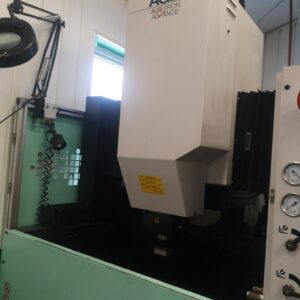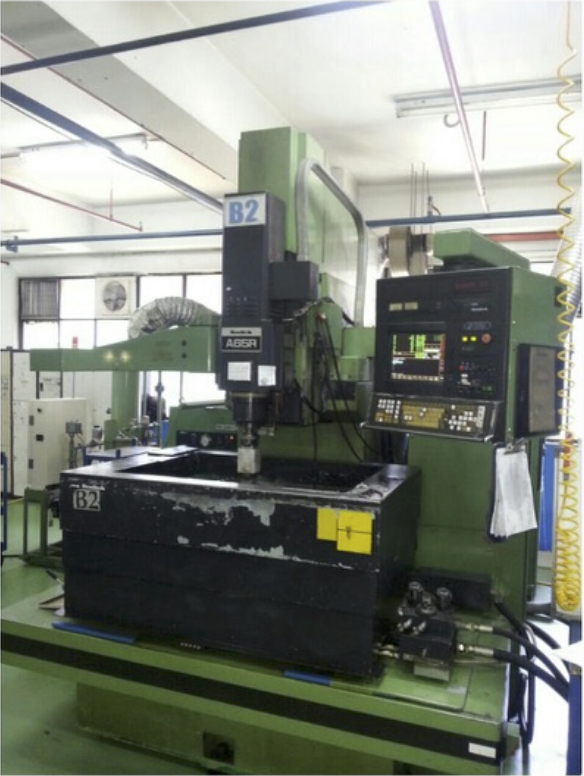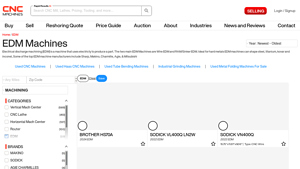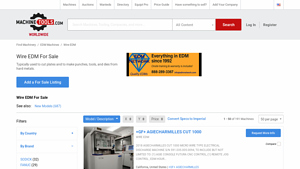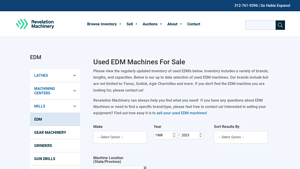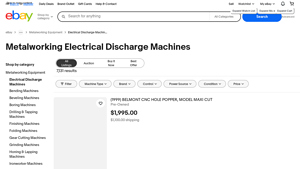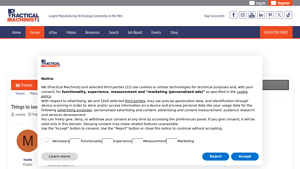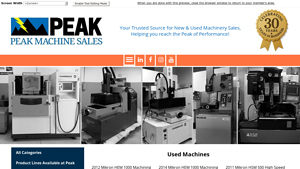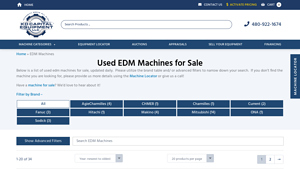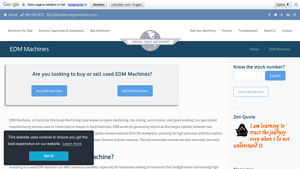Used Edm Machines Guide: Type, Cost, Top List…
Introduction: Navigating the Global Market for used edm machines
In the competitive landscape of manufacturing, sourcing used EDM machines presents a unique challenge for B2B buyers, particularly in regions like Africa, South America, the Middle East, and Europe. The intricacies involved in selecting the right equipment—whether it be wire EDM or ram/sinker EDM—can significantly impact operational efficiency and production quality. This guide serves as a comprehensive resource designed to empower international buyers with the knowledge needed to navigate the global market for used EDM machines.
Within these pages, you will find detailed insights into various types of EDM machines, their specific applications across industries such as aerospace, automotive, and mold-making, and essential criteria for vetting suppliers. Additionally, we delve into cost considerations, helping you understand the pricing landscape and how to secure the best value for your investment.
By equipping you with actionable information and expert recommendations, this guide aims to enhance your purchasing decisions, ensuring that you select the right used EDM machine tailored to your operational needs. Whether you’re based in Nigeria, Germany, or beyond, understanding the nuances of used EDM machinery will not only streamline your procurement process but also position your business for long-term success in a demanding marketplace.
Understanding used edm machines Types and Variations
| Type Name | Key Distinguishing Features | Primary B2B Applications | Brief Pros & Cons for Buyers |
|---|---|---|---|
| Wire EDM | Utilizes a thin wire as an electrode for precise cuts; excellent for intricate shapes. | Aerospace, automotive, and mold-making industries. | Pros: High accuracy, minimal material waste. Cons: Slower for large, simple parts. |
| Ram (Sinker) EDM | Employs a shaped electrode to create cavities; suitable for deeper cuts. | Die manufacturing, complex part fabrication. | Pros: Excellent for deep cavities; versatile. Cons: Can generate debris and requires cleanup. |
| Small Hole EDM | Designed for drilling small holes with high precision; often used for intricate designs. | Electronics and medical device manufacturing. | Pros: Precision in small diameters; effective in hard materials. Cons: Limited to small applications. |
| CNC EDM | Computer-controlled for automated operations; enhances precision and efficiency. | High-volume production in various industries. | Pros: Increased productivity; reduced human error. Cons: Higher initial investment; requires skilled operators. |
| Hole Popper EDM | Specialized for creating small, precise holes; often used in conjunction with other EDM processes. | Aerospace and automotive industries for complex assemblies. | Pros: Fast operation for small holes; minimal material removal. Cons: Limited to specific applications. |
What are the Key Characteristics of Wire EDM Machines?
Wire EDM machines are distinguished by their use of a thin metal wire, which acts as an electrode to make precise cuts in conductive materials. This method is particularly effective for creating complex geometries and intricate details, making it ideal for industries such as aerospace and automotive where precision is paramount. When considering a Wire EDM machine, buyers should evaluate factors such as cutting speed, wire diameter capabilities, and the machine’s overall size to ensure it meets their production needs.
How Does Ram (Sinker) EDM Differ from Other Types?
Ram EDM, also known as sinker EDM, utilizes a shaped electrode to erode material and create cavities in the workpiece. This type of EDM is well-suited for applications requiring deep cuts and complex internal features, commonly found in die manufacturing. Buyers should consider electrode wear rates, maintenance requirements, and the potential for debris generation when selecting a Ram EDM machine, as these factors can impact operational efficiency.
Why Choose Small Hole EDM for Precision Applications?
Small Hole EDM machines are specifically engineered for drilling tiny, precise holes in hard materials. This technology is widely used in the electronics and medical device sectors, where intricate designs are commonplace. When purchasing a Small Hole EDM, companies should assess the machine’s hole diameter capabilities and operational speed, as these will directly influence production efficiency and output quality.
What Advantages Do CNC EDM Machines Offer?
CNC EDM machines leverage computer numerical control to automate the machining process, enhancing precision and productivity. This technology is particularly beneficial for high-volume production settings across various industries. B2B buyers should consider the initial investment and the need for skilled personnel to operate these machines effectively, as these factors can significantly affect the return on investment.
How Do Hole Popper EDM Machines Enhance Manufacturing Processes?
Hole Popper EDM machines are specialized for creating small, accurate holes and are often used in conjunction with other EDM processes for complex assemblies in sectors like aerospace and automotive. Their speed and precision make them valuable assets in manufacturing workflows. Buyers should evaluate the machine’s operational speed and compatibility with other equipment to ensure seamless integration into their production processes.
Key Industrial Applications of used edm machines
| Industry/Sector | Specific Application of used edm machines | Value/Benefit for the Business | Key Sourcing Considerations for this Application |
|---|---|---|---|
| Aerospace | Manufacturing complex components for aircraft | High precision and reliability in critical components | Ensure machines can handle specific materials like titanium |
| Automotive | Production of intricate parts for vehicles | Enhanced accuracy in part fabrication, reducing rework | Look for EDM machines with automated features for efficiency |
| Mold and Die Making | Creation of molds for plastics and metals | Capability to produce detailed and durable molds | Assess the machine’s compatibility with various mold materials |
| Medical Devices | Fabrication of surgical instruments and implants | Ability to work with biocompatible materials | Verify precision capabilities and compliance with health standards |
| Electronics | Manufacturing components for circuit boards | Precision in creating complex geometries | Focus on sourcing machines that support small, intricate parts |
How Are Used EDM Machines Applied in Aerospace Manufacturing?
In the aerospace sector, used EDM machines are essential for manufacturing complex components such as turbine blades and structural parts that require high precision. These machines can efficiently work with hard metals like titanium and inconel, which are commonly used in aircraft due to their strength and lightweight properties. Buyers from regions like Europe and the Middle East should prioritize sourcing machines that are capable of handling these materials with tight tolerances to ensure safety and performance standards are met.
What Role Do Used EDM Machines Play in Automotive Production?
The automotive industry relies on used EDM machines for producing intricate parts such as fuel injectors, gears, and molds. The ability to create precise components means reduced rework and scrap rates, which directly impacts profitability. Buyers, especially in South America and Africa, should consider the machine’s automation features to enhance production efficiency and reduce labor costs, ensuring a better return on investment.
How Are Used EDM Machines Utilized in Mold and Die Making?
In mold and die making, used EDM machines are instrumental in creating detailed molds for both plastic and metal components. Their precision allows manufacturers to produce high-quality molds that meet exact specifications, reducing the need for extensive finishing work. When sourcing, businesses should evaluate the machine’s compatibility with various mold materials and its capability to handle intricate designs, which is crucial for maintaining competitiveness in global markets.
What Are the Applications of Used EDM Machines in Medical Device Manufacturing?
Used EDM machines are vital in the medical industry for fabricating surgical instruments and implants with intricate geometries. These machines can work with biocompatible materials, ensuring that the products meet stringent health standards. International buyers, particularly from Europe, should focus on the precision capabilities of these machines, as well as their compliance with industry regulations to ensure safety and efficacy in medical applications.
How Are Used EDM Machines Beneficial in Electronics Manufacturing?
In electronics, used EDM machines are used to manufacture components for circuit boards and other delicate electronic devices. Their ability to create small, intricate parts with high precision is invaluable in this fast-evolving sector. Buyers should prioritize sourcing machines that support a wide range of materials and have capabilities for fine detail work, as this will enhance their production quality and efficiency in the competitive electronics market.
3 Common User Pain Points for ‘used edm machines’ & Their Solutions
Scenario 1: Struggling with Unreliable Machine Performance
The Problem: Many B2B buyers of used EDM machines often face the challenge of inconsistent performance. When investing in used equipment, there can be uncertainties regarding the machine’s operational history, maintenance records, and the potential for wear and tear. For instance, a manufacturer in Nigeria may purchase a used wire EDM only to discover that it frequently malfunctions, leading to production delays and increased operational costs. This unpredictability can hinder productivity and negatively impact customer satisfaction.
The Solution: To mitigate this issue, buyers should prioritize thorough inspections and audits of potential purchases. Before making a decision, engage a trusted technician to evaluate the machine’s condition and operational history. Request documentation of maintenance records and any repairs made. Additionally, consider sourcing machines from reputable dealers who offer warranties or guarantees on their used EDM machines. This proactive approach not only enhances confidence in the machine’s reliability but also ensures a smoother integration into existing operations.
Scenario 2: Navigating Complex Technical Specifications
The Problem: Buyers often struggle with the technical specifications of used EDM machines, leading to mismatches between machine capabilities and production needs. For example, a small automotive parts manufacturer in Germany may require a machine that can handle intricate designs but ends up purchasing a unit with limited cutting capabilities, resulting in inefficiencies and wasted resources. This scenario is particularly common when buyers are not well-versed in the nuances of EDM technology.
The Solution: To address this pain point, it’s crucial to conduct comprehensive research on the specific EDM technology that aligns with your production requirements. Create a checklist of essential specifications, such as cutting speed, electrode types, and material compatibility. Consulting with industry experts or suppliers can provide valuable insights into selecting the right machine. Additionally, consider attending industry trade shows or workshops to gain a deeper understanding of the latest technologies and trends in EDM, which can help inform better purchasing decisions.
Scenario 3: High Maintenance Costs and Downtime
The Problem: High maintenance costs and unexpected downtime are significant concerns for businesses using used EDM machines. A manufacturer in Brazil may find that the operational costs for maintaining an older model escalate quickly due to the need for specialized parts or frequent repairs. This can severely disrupt production schedules and impact profitability, particularly in competitive markets.
The Solution: To minimize maintenance costs and downtime, buyers should prioritize purchasing machines with readily available parts and strong aftermarket support. Research the availability of consumables and components for different machine brands and models before making a purchase. It’s advisable to choose well-known manufacturers with established support networks, such as Mitsubishi or AgieCharmilles, as they often have a robust supply chain for parts. Furthermore, implementing a preventative maintenance schedule can proactively address potential issues before they escalate, ensuring the EDM machine operates efficiently and reducing unplanned downtime. Regular training for operators on best practices for machine use can also contribute to extending the lifespan of the equipment and reducing maintenance needs.
Strategic Material Selection Guide for used edm machines
What Are the Key Materials Used in EDM Machines?
When selecting used EDM machines, understanding the materials involved in their construction and operation is crucial for B2B buyers. The choice of materials can significantly influence machine performance, durability, and suitability for specific applications. Here, we analyze four common materials used in EDM machines: Steel, Copper, Graphite, and Tungsten.
How Does Steel Contribute to EDM Machine Performance?
Steel, particularly high-carbon and alloy steel, is often used in the construction of EDM machine frames and components. Its key properties include high tensile strength and durability, allowing machines to withstand the rigors of operation. However, steel can be prone to corrosion, which may necessitate additional protective coatings.
Pros: Steel is relatively inexpensive, widely available, and offers excellent structural integrity. Its durability makes it suitable for heavy-duty applications.
Cons: The potential for rust and corrosion can lead to increased maintenance costs. Moreover, machining high-carbon steel can be complex, requiring specialized tools.
Impact on Application: Steel’s strength and durability make it suitable for high-pressure applications. However, its susceptibility to corrosion may limit its use in environments with high humidity or chemical exposure.
Considerations for International Buyers: Compliance with international standards such as ASTM and DIN is essential. Buyers should ensure that the steel used meets specific grade requirements for their region, especially in industries like automotive and aerospace.
What Role Does Copper Play in EDM Machines?
Copper is frequently used for electrodes in EDM processes due to its excellent electrical conductivity and thermal properties. It allows for efficient sparking and heat dissipation, which are critical for precision machining.
Pros: Copper electrodes provide high machining accuracy and are relatively easy to manufacture. They also have good wear resistance, leading to longer electrode life.
Cons: Copper can be more expensive than other materials and may require frequent replacement in high-volume operations. Additionally, it can be less effective in certain applications where higher melting point materials are needed.
Impact on Application: Copper electrodes are particularly effective in applications requiring intricate detail, such as mold-making and aerospace components.
Considerations for International Buyers: Buyers should be aware of the specific grades of copper that comply with local standards, as well as the potential for import tariffs or restrictions on specific alloys.
Why is Graphite a Preferred Material for EDM Electrodes?
Graphite is another popular material for EDM electrodes, known for its high melting point and excellent machinability. Its properties include good thermal conductivity and low density, making it ideal for complex shapes.
Pros: Graphite electrodes are lightweight and have a high resistance to thermal shock. They also tend to produce less wear on the EDM machine.
Cons: The dust generated during machining can create a mess and requires effective filtration systems. Additionally, graphite can be brittle, leading to breakage if not handled carefully.
Impact on Application: Graphite is especially suitable for applications requiring high precision and intricate shapes, such as in the aerospace and automotive industries.
Considerations for International Buyers: Compliance with international standards for graphite quality is essential, particularly in high-precision applications. Buyers should also consider local environmental regulations regarding dust management.
How Does Tungsten Enhance EDM Machine Functionality?
Tungsten is often used in specialized applications where high wear resistance and thermal stability are required. Its properties include a high melting point and excellent hardness, making it suitable for challenging machining tasks.
Pros: Tungsten electrodes provide exceptional durability and can withstand high temperatures without deforming. They are ideal for heavy-duty applications.
Cons: Tungsten is significantly more expensive than other materials, which can increase overall operational costs. Additionally, its density makes it heavier, potentially complicating handling and setup.
Impact on Application: Tungsten is particularly advantageous in applications requiring high precision and durability, such as in the production of aerospace components.
Considerations for International Buyers: Buyers should ensure that tungsten materials comply with international standards, as well as consider the higher costs associated with importing tungsten products.
Summary Table of Material Selection for Used EDM Machines
| Material | Typical Use Case for used edm machines | Key Advantage | Key Disadvantage/Limitation | Relative Cost (Low/Med/High) |
|---|---|---|---|---|
| Steel | Machine frames and structural components | High tensile strength and durability | Prone to corrosion | Medium |
| Copper | Electrodes for precision machining | Excellent electrical conductivity | Higher cost and frequent replacement | High |
| Graphite | Electrodes for intricate shapes | Lightweight and high thermal resistance | Dust generation and brittleness | Medium |
| Tungsten | Heavy-duty applications | Exceptional durability and heat resistance | High cost and handling complexity | High |
This comprehensive analysis provides B2B buyers with essential insights into material selection for used EDM machines, ensuring informed purchasing decisions that align with operational needs and regional standards.
In-depth Look: Manufacturing Processes and Quality Assurance for used edm machines
What Are the Main Stages in the Manufacturing Process of Used EDM Machines?
The manufacturing process for used Electrical Discharge Machining (EDM) machines involves several critical stages that ensure the machines meet high standards of performance and quality. Understanding these stages can help B2B buyers make informed decisions when purchasing used equipment.
Material Preparation: How Is the Foundation Set for EDM Machines?
The process begins with material preparation, where high-quality metals such as steel, titanium, and alloyed materials are sourced. The selection of raw materials is crucial, as the durability and performance of the EDM machine depend significantly on the quality of the materials used. Manufacturers often conduct thorough inspections to assess material properties like hardness, tensile strength, and resistance to wear.
Once the materials are sourced, they undergo cutting and shaping to form the base components of the EDM machine. Techniques such as laser cutting and CNC machining are commonly employed to ensure precision and uniformity in the parts.
Forming: What Techniques Are Used to Shape EDM Components?
The next stage involves forming, where the prepared materials are shaped into specific components using techniques like forging, casting, or machining. For EDM machines, critical components such as the electrode holders, worktables, and frames are produced in this stage.
In particular, wire EDM is used to create intricate shapes and features that are difficult to achieve with traditional machining methods. This not only enhances the machine’s capabilities but also allows for the production of complex geometries that are essential for modern manufacturing applications.
Assembly: How Are EDM Machines Constructed?
Following the forming process, the assembly stage brings together the various components to construct the EDM machine. This stage is crucial, as it requires precision and attention to detail to ensure that all parts fit together correctly and function as intended.
Typically, assembly includes the installation of electrical systems, control panels, and hydraulic components. Skilled technicians perform this work, often following strict assembly protocols to maintain quality standards. The use of standard operating procedures (SOPs) during assembly ensures consistency and reliability across production batches.
Finishing: What Final Touches Are Applied to Enhance Performance?
The finishing stage includes surface treatments, painting, and final inspections. Surface treatments such as anodizing or coating are applied to enhance corrosion resistance and wearability, which are vital for the longevity of the machine.
Final inspections are performed to verify that all components meet design specifications and operational standards. This may involve functional testing, where the machine is operated under controlled conditions to ensure that it performs as expected.
What Quality Assurance Standards Are Relevant for Used EDM Machines?
Quality assurance (QA) is an essential aspect of manufacturing used EDM machines. B2B buyers should be aware of the relevant international standards and industry-specific certifications that can impact their purchasing decisions.
Which International Standards Should Buyers Consider?
ISO 9001 is a widely recognized standard that outlines the criteria for a quality management system. Manufacturers that are ISO 9001 certified demonstrate a commitment to quality and continuous improvement, which can be an essential factor for buyers looking for reliable used EDM machines.
In addition to ISO certifications, industry-specific standards such as CE marking for compliance with European safety, health, and environmental protection standards can be significant for buyers in Europe. Buyers from Africa and South America should look for compliance with local regulations and standards that may vary by region.
What Are the Key Quality Control Checkpoints in EDM Manufacturing?
Quality control (QC) is implemented at several checkpoints throughout the manufacturing process:
-
Incoming Quality Control (IQC): This initial checkpoint involves inspecting the raw materials upon receipt to ensure they meet specified standards.
-
In-Process Quality Control (IPQC): During the manufacturing process, ongoing inspections are performed to monitor the quality of components being formed and assembled. This may include dimensional checks and functional testing of key machine parts.
-
Final Quality Control (FQC): After assembly and finishing, a thorough inspection is conducted to verify that the completed EDM machine meets all quality standards. This includes performance testing under various operational conditions.
How Can B2B Buyers Verify Supplier Quality Control Practices?
Buyers should take proactive steps to verify the quality control practices of potential suppliers, especially when sourcing used EDM machines from international markets.
What Should Buyers Look for in Supplier Audits and Reports?
Requesting detailed audit reports and quality assurance documentation from suppliers can provide insights into their QC processes. Many reputable manufacturers will have documentation readily available, including records of inspections, test results, and compliance with relevant standards.
How Can Third-Party Inspections Enhance Buyer Confidence?
Engaging third-party inspection services can further enhance buyer confidence in the quality of used EDM machines. Independent inspectors can evaluate the machines before purchase, providing an unbiased assessment of their condition and performance.
What Are the Quality Control Nuances for International B2B Buyers?
International buyers, particularly from Africa, South America, the Middle East, and Europe, should be aware of certain nuances in quality control practices.
How Do Regional Standards Affect Quality Assurance?
Regional standards and regulations can vary significantly. Buyers should familiarize themselves with local requirements and certifications that may affect machine operation and safety. For instance, certain countries may have stricter environmental regulations that require compliance from manufacturers.
What Role Does Communication Play in Ensuring Quality?
Effective communication with suppliers is vital for ensuring that quality expectations are met. Buyers should discuss quality standards upfront, clarify any specific requirements, and establish protocols for addressing quality issues that may arise post-purchase.
In summary, understanding the manufacturing processes and quality assurance measures associated with used EDM machines is crucial for B2B buyers. By focusing on material preparation, forming, assembly, and finishing stages, along with relevant international standards and quality control practices, buyers can make informed decisions that align with their operational needs and quality expectations.
Practical Sourcing Guide: A Step-by-Step Checklist for ‘used edm machines’
Introduction
Sourcing used EDM machines requires a strategic approach to ensure that you acquire equipment that meets your operational needs while offering value for your investment. This checklist serves as a practical guide for B2B buyers, particularly in regions such as Africa, South America, the Middle East, and Europe, to navigate the complexities of the used EDM market.
Step 1: Define Your Technical Specifications
Before diving into the market, clearly outline your technical requirements. Determine the type of EDM machine you need—whether Wire EDM or Ram (Sinker) EDM—and specify parameters such as workpiece size, material compatibility, and desired accuracy levels. This initial step is crucial to narrow down options and avoid purchasing equipment that doesn’t meet your production needs.
Step 2: Set a Realistic Budget
Establishing a budget is essential for guiding your purchasing decisions. Consider not only the upfront cost of the machine but also ongoing expenses such as maintenance, operational costs, and potential upgrades. Prices for used EDM machines can vary significantly, so having a clear budget helps prioritize options that offer the best value within your financial constraints.
Step 3: Research Reputable Suppliers
Identifying reliable suppliers is key to a successful purchase. Look for suppliers with a solid track record in the EDM market, preferably with experience in your region. Check their online presence, read reviews, and request references to gauge their reliability and customer service. A reputable supplier will provide transparency about the machine’s condition and history.
Step 4: Inspect Equipment Thoroughly
Once you’ve shortlisted potential machines, arrange for a detailed inspection. Assess the physical condition, maintenance records, and operational history of the equipment. Look for signs of wear and tear, and verify that all components are functioning correctly. If possible, request a demonstration to ensure that the machine operates as expected.
Step 5: Verify Certifications and Compliance
Ensure that the used EDM machines comply with relevant industry standards and certifications. Compliance with safety regulations and quality standards is vital for ensuring operational reliability and worker safety. Request documentation that confirms the machine’s adherence to these standards to mitigate risks associated with equipment failure.
Step 6: Understand Warranty and Support Options
Before finalizing your purchase, clarify the warranty terms and after-sales support offered by the supplier. A robust warranty can provide peace of mind and protect your investment against unforeseen issues. Additionally, inquire about the availability of spare parts and technical support, as these factors are crucial for minimizing downtime in your operations.
Step 7: Negotiate Terms and Finalize Purchase
Once you’ve completed your due diligence, engage in negotiations with the supplier. Be prepared to discuss pricing, payment terms, and delivery timelines. Ensure that all agreed-upon terms are documented in a purchase agreement to avoid misunderstandings later. Finalizing the purchase with clear terms protects both parties and facilitates a smoother transaction.
By following this checklist, you can approach the procurement of used EDM machines with confidence, ensuring that your investment aligns with your production goals and operational requirements.
Comprehensive Cost and Pricing Analysis for used edm machines Sourcing
What Are the Key Cost Components for Used EDM Machines?
When sourcing used Electrical Discharge Machining (EDM) machines, buyers need to understand the underlying cost structure. The primary cost components include:
-
Materials: The type and quality of materials used in the EDM machine significantly influence the cost. High-quality components tend to enhance durability and performance, thereby impacting the overall pricing.
-
Labor: Labor costs can vary based on the complexity of assembly and maintenance. Machines that require skilled technicians for repairs or calibration may incur higher labor costs.
-
Manufacturing Overhead: This encompasses all indirect costs related to production, such as utilities, rent, and administrative expenses. Overhead can vary widely depending on the supplier’s location and operational efficiency.
-
Tooling: Custom tooling may be necessary for specific applications, adding to the initial investment. Buyers should consider whether the machine comes with necessary tooling or if additional purchases are required.
-
Quality Control (QC): Implementing stringent QC processes ensures the machine’s reliability and accuracy, but it also adds to the cost. Machines that have undergone rigorous quality checks may command higher prices.
-
Logistics: Shipping costs can significantly affect the total expenditure, particularly for international transactions. Factors like distance, shipping method, and packaging contribute to logistics expenses.
-
Margin: Suppliers typically mark up prices based on their desired profit margins. Understanding industry standards for margins can help buyers negotiate better deals.
How Do Price Influencers Impact the Cost of Used EDM Machines?
Several factors influence the pricing of used EDM machines, making it essential for buyers to consider:
-
Volume/MOQ (Minimum Order Quantity): Purchasing in larger volumes often leads to better pricing. Suppliers may offer discounts for bulk orders, making it a cost-efficient strategy for businesses with ongoing needs.
-
Specifications and Customization: Machines with specialized features or custom modifications tend to be priced higher. Buyers should assess whether standard specifications meet their needs to avoid unnecessary costs.
-
Materials and Quality Certifications: Machines made from high-grade materials and with industry certifications (e.g., ISO) may attract premium prices. Buyers should evaluate the value of certifications against their operational requirements.
-
Supplier Factors: The reputation and reliability of the supplier can significantly affect pricing. Established brands with a history of performance may command higher prices due to perceived value and support.
-
Incoterms: The agreed terms of shipment (Incoterms) can alter the overall cost structure. Understanding responsibilities for shipping, insurance, and tariffs is vital for calculating total expenses.
What Are Effective Buyer Tips for Sourcing Used EDM Machines?
Navigating the market for used EDM machines requires strategic insights for cost efficiency. Here are some tips:
-
Negotiate Wisely: Always approach negotiations with a clear understanding of market prices. Leverage information about competitor pricing and machine conditions to secure better deals.
-
Consider Total Cost of Ownership (TCO): Beyond the initial purchase price, evaluate ongoing costs such as maintenance, operational efficiency, and potential downtime. A machine with a lower upfront cost may incur higher TCO if it requires frequent repairs.
-
Pricing Nuances for International Buyers: Buyers from regions like Africa, South America, and the Middle East should account for additional costs such as import duties, taxes, and shipping logistics. Understanding local regulations and customs processes is crucial to avoid unexpected expenses.
-
Research Local Markets: Familiarize yourself with local market conditions and pricing trends. This knowledge can help negotiate better terms and identify potential suppliers.
Disclaimer on Indicative Prices
Prices for used EDM machines can fluctuate based on market demand, machine condition, and supplier pricing strategies. The information provided serves as a guideline and may not reflect current market conditions. Always consult with multiple suppliers and conduct thorough due diligence before making purchasing decisions.
Alternatives Analysis: Comparing used edm machines With Other Solutions
Exploring Alternatives to Used EDM Machines
In the realm of precision manufacturing, Electrical Discharge Machining (EDM) has established itself as a vital technology for producing intricate components. However, buyers often seek alternatives that may better suit their specific operational needs or budget constraints. This analysis compares used EDM machines with two viable alternatives: CNC Machining and Laser Cutting. Each method has distinct advantages and limitations that can influence a buyer’s decision.
| Comparison Aspect | Used EDM Machines | CNC Machining | Laser Cutting |
|---|---|---|---|
| Performance | High precision for hard metals; excellent for complex shapes | Versatile; good for a wide range of materials | Fast cutting speeds; good for thin materials |
| Cost | Moderate to high; varies with age and condition | Varies widely; can be more economical for simple tasks | Generally lower operational costs; initial setup can be high |
| Ease of Implementation | Requires skilled operators; may need training for older models | User-friendly with modern interfaces; less training needed | Typically straightforward; minimal training required |
| Maintenance | Regular maintenance needed for optimal performance; can be costly | Generally low maintenance; depends on the machine quality | Low maintenance; focus on lens and gas supply management |
| Best Use Case | Ideal for precision molds, aerospace, and automotive parts | Best for bulk production and diverse material types | Suitable for signage, automotive, and lightweight materials |
In-Depth Analysis of Alternatives
CNC Machining
CNC (Computer Numerical Control) machining is a widely adopted manufacturing process that utilizes computer systems to control machining tools. This method excels in producing parts from various materials, including metals, plastics, and composites. The main advantage of CNC machining lies in its versatility; it can create complex geometries and achieve high tolerances with relative ease. However, while CNC machines can handle a variety of materials, they may not match the precision of EDM when it comes to intricate designs in extremely hard materials. Additionally, while operational costs can be lower for simpler tasks, the initial investment in high-quality CNC machines can be significant.
Laser Cutting
Laser cutting is a modern technology that employs focused laser beams to cut or engrave materials. It offers high-speed processing and is particularly effective for thin materials such as plastics, wood, and certain metals. The advantages of laser cutting include lower operational costs and a simpler setup compared to EDM. However, it may not be suitable for thicker materials or complex shapes that require high precision, which can limit its applications in industries that demand intricate detailing, such as aerospace or medical device manufacturing. Additionally, laser cutting does not work well with reflective materials, which can be a drawback for certain applications.
Conclusion: Choosing the Right Solution for Your Needs
When evaluating whether to invest in used EDM machines or consider alternatives like CNC machining or laser cutting, B2B buyers should carefully assess their specific requirements, including the types of materials they work with, the complexity of the parts they need to produce, and their budget constraints. Each solution presents unique benefits and challenges, making it essential to align the chosen technology with operational goals. Conducting a thorough analysis of these factors will enable businesses to make informed decisions that enhance productivity and efficiency in their manufacturing processes.
Essential Technical Properties and Trade Terminology for used edm machines
When considering the purchase of used EDM machines, understanding the essential technical properties and industry terminology is crucial for making informed decisions. Below, we explore key specifications and common trade terms that can significantly impact your investment.
What Are the Key Technical Properties of Used EDM Machines?
1. Material Compatibility
EDM machines are designed to work with a variety of hard metals, including steel, titanium, and inconel. Understanding the material compatibility of a machine is essential for buyers, as it determines the types of projects the machine can handle. Selecting a machine that can process the specific materials required by your business will enhance production efficiency and reduce the risk of tool wear.
2. Tolerance Levels
Tolerance refers to the allowable variation in a manufactured part’s dimensions. In the context of EDM, precision is paramount, with tolerances often as tight as ±0.0001 inches. For industries like aerospace and medical manufacturing, where precision is critical, knowing the machine’s tolerance capabilities is vital for meeting stringent quality standards.
3. Cutting Speed
Cutting speed indicates how quickly a machine can remove material from a workpiece. This metric is crucial for productivity, as faster cutting speeds lead to shorter cycle times and increased output. When evaluating used EDM machines, inquire about the cutting speed specifications to ensure they align with your production goals.
4. Electrode Type and Usage
The type of electrode used in EDM processes can affect machining efficiency and quality. Common electrode materials include copper, graphite, and brass, each offering different advantages in terms of wear resistance and conductivity. Understanding the electrode requirements for a specific machine helps in maintaining operational efficiency and cost-effectiveness.
5. Control System
The control system of an EDM machine can range from basic manual controls to advanced CNC capabilities. A sophisticated control system can enhance automation, improve precision, and simplify the programming of complex parts. Assessing the machine’s control system is essential for maximizing operational effectiveness and adapting to evolving production needs.
What Are the Common Trade Terms in the EDM Industry?
1. OEM (Original Equipment Manufacturer)
An OEM refers to a company that produces equipment or components that are sold under another brand’s name. Understanding OEM specifications is essential when sourcing replacement parts for your EDM machine, as compatibility and quality can vary significantly between manufacturers.
2. MOQ (Minimum Order Quantity)
MOQ is the smallest quantity of a product that a supplier is willing to sell. This term is particularly important when purchasing parts or consumables for EDM machines, as it can affect your inventory costs and purchasing strategy.
3. RFQ (Request for Quotation)
An RFQ is a formal process where a buyer requests pricing and terms from suppliers. This is a critical step in the procurement process, enabling businesses to compare offers and negotiate better deals for used EDM machines or related components.
4. Incoterms (International Commercial Terms)
Incoterms are internationally recognized rules that define the responsibilities of buyers and sellers in international transactions. Familiarity with these terms is crucial for B2B buyers, as they dictate the delivery conditions, risk transfers, and costs associated with shipping EDM machines across borders.
5. Aftermarket Support
This term refers to the services and parts available for a machine after the initial sale. For used EDM machines, assessing the availability of aftermarket support can be a deciding factor, as reliable service can significantly reduce downtime and maintenance costs.
Understanding these technical properties and trade terminology will empower you to make informed decisions when purchasing used EDM machines, ensuring that your investment aligns with your operational needs and business goals.
Navigating Market Dynamics and Sourcing Trends in the used edm machines Sector
What are the Current Market Dynamics and Key Trends in Used EDM Machines?
The market for used Electrical Discharge Machining (EDM) machines is influenced by various global drivers, including the increasing demand for precision manufacturing across sectors such as aerospace, automotive, and medical devices. The rise of advanced manufacturing technologies and automation has made EDM an attractive option for companies looking to enhance their production capabilities without the significant investment required for new machines. Key trends include the growth of digital platforms that facilitate the buying and selling of used machinery, making it easier for international B2B buyers, particularly from regions like Africa, South America, the Middle East, and Europe, to access a wider range of options.
Emerging technologies such as Industry 4.0 and IoT are also reshaping the landscape. Manufacturers are increasingly looking for machines that offer connectivity features for predictive maintenance and operational efficiency. This trend is particularly relevant for buyers in Europe and Germany, where technological innovation is paramount. In contrast, buyers in regions like Nigeria and South America may prioritize cost-effectiveness and reliability, leading to a growing interest in refurbished machines that provide the necessary capabilities at a lower price point.
Moreover, the competitive landscape is evolving, with a diverse range of manufacturers and resellers offering used EDM machines. Buyers should pay attention to brand reputation and machine history, as these factors significantly influence machine performance and longevity.
How is Sustainability and Ethical Sourcing Impacting the Used EDM Machines Market?
Sustainability has become a focal point for many businesses, and the sourcing of used EDM machines is no exception. The environmental impact of manufacturing processes and machine disposal is under scrutiny, prompting buyers to seek out machines that are refurbished or certified as ‘green.’ Utilizing used EDM machines not only extends the lifecycle of existing equipment but also reduces waste and energy consumption associated with manufacturing new machines.
The importance of ethical supply chains is gaining traction, especially among B2B buyers in Europe and the Middle East, where regulatory frameworks around sustainability are becoming more stringent. Buyers are encouraged to inquire about the sourcing practices of their suppliers, including the environmental certifications of machines and the processes used to refurbish them. Certifications such as ISO 14001 can indicate a commitment to reducing environmental impact.
In addition, companies are beginning to prioritize suppliers that demonstrate corporate social responsibility (CSR) practices. This trend emphasizes the need for transparency in sourcing, ensuring that machines are not only environmentally friendly but also produced under fair labor conditions.
What is the Brief Evolution and History of EDM Machines Relevant to B2B Buyers?
Electrical Discharge Machining has evolved significantly since its inception in the 1950s. Originally developed for die sinking, the technology has expanded to include wire EDM and small hole EDM, offering precision machining capabilities for a variety of materials. The introduction of CNC technology in the 1980s revolutionized the EDM sector, enabling higher accuracy and automation, which are now essential in modern manufacturing processes.
Over the decades, advances in power supply technology and electrode materials have improved machining speeds and reduced wear, enhancing productivity. For B2B buyers, understanding this evolution is crucial as it highlights the advancements in machine capabilities that can impact operational efficiency and product quality. Investing in used EDM machines from reputable manufacturers can provide access to these technological advancements at a fraction of the cost of new equipment, making it a strategic choice for businesses aiming to stay competitive in the global market.
Frequently Asked Questions (FAQs) for B2B Buyers of used edm machines
-
1. How do I evaluate the quality of a used EDM machine before purchase?
To evaluate the quality of a used EDM machine, start by reviewing its maintenance history and service records. Request detailed specifications such as the machine’s age, hours of operation, and any upgrades or repairs that have been made. Conduct a physical inspection, if possible, to check for signs of wear or damage. It’s also beneficial to ask for a demonstration of the machine in operation to assess its performance and accuracy. Finally, consider obtaining references from previous users to gauge their satisfaction with the machine. -
2. What is the best type of used EDM machine for my manufacturing needs?
The best type of used EDM machine depends on your specific manufacturing requirements. For intricate shapes and high precision in hard materials, a Wire EDM machine is ideal, while a Ram (Sinker) EDM machine is better for creating cavities and complex forms. Consider factors such as the types of materials you work with, the required accuracy, and your production volume when choosing. It’s also advisable to consult with suppliers to get insights into which models have proven reliable in similar applications. -
3. What are the common issues to look for in used EDM machines?
Common issues in used EDM machines include excessive wear on components, outdated technology that may not meet current production needs, and inadequate maintenance that can lead to operational inefficiencies. Look for signs of electrical problems, coolant leaks, or worn-out electrodes. Additionally, verify that the machine’s software is up to date and compatible with modern production requirements. Understanding the machine’s operational history can also provide insight into potential long-term reliability. -
4. How do I ensure a smooth international transaction when purchasing used EDM machines?
To ensure a smooth international transaction, start by thoroughly vetting the supplier. Check their reputation through online reviews and industry references. Understand the logistics involved, including shipping options, customs duties, and import regulations specific to your country. It’s also essential to discuss payment terms upfront, including deposits, payment methods, and guarantees. Consider using a reputable escrow service for larger transactions to protect both parties. Lastly, make sure to have a clear contract outlining all terms and conditions. -
5. What is the minimum order quantity (MOQ) for used EDM machines?
The minimum order quantity for used EDM machines can vary significantly based on the supplier and the specific machines in question. Some suppliers may offer single units, while others may have MOQs tied to bulk purchasing discounts. When negotiating, communicate your needs clearly and explore options that fit your operational scale. If you’re considering multiple machines, suppliers may be more flexible with MOQs, especially if it leads to a larger overall sale. -
6. What payment terms should I expect when purchasing used EDM machines internationally?
Payment terms for purchasing used EDM machines internationally can vary by supplier and region. Common options include upfront payments, deposits followed by balance payments upon delivery, or financing arrangements. Ensure you understand the currency exchange implications and transaction fees associated with international payments. It’s advisable to negotiate terms that provide you with sufficient security, such as escrow services or letters of credit, to safeguard your investment until the machine is delivered and operational. -
7. How can I customize a used EDM machine to fit my production needs?
Customizing a used EDM machine typically involves assessing its current capabilities and identifying necessary modifications to meet your specific production requirements. This may include upgrading software, adding new tooling or electrodes, or modifying the machine’s settings for different materials or processes. Consult with the supplier to discuss available customization options and any associated costs. In some cases, third-party specialists may be able to assist with more complex modifications or enhancements. -
8. What quality assurance measures should I implement after purchasing a used EDM machine?
After purchasing a used EDM machine, implement a robust quality assurance program to ensure optimal performance. Begin with a comprehensive inspection and calibration of the machine to align it with your production standards. Regularly monitor its output for precision and consistency, and maintain a log of any issues that arise. Additionally, establish a routine maintenance schedule to address wear and tear proactively. Training your operators on best practices can also enhance the machine’s longevity and efficiency in your production process.
Important Disclaimer & Terms of Use
⚠️ Important Disclaimer
The information provided in this guide, including content regarding manufacturers, technical specifications, and market analysis, is for informational and educational purposes only. It does not constitute professional procurement advice, financial advice, or legal advice.
While we have made every effort to ensure the accuracy and timeliness of the information, we are not responsible for any errors, omissions, or outdated information. Market conditions, company details, and technical standards are subject to change.
B2B buyers must conduct their own independent and thorough due diligence before making any purchasing decisions. This includes contacting suppliers directly, verifying certifications, requesting samples, and seeking professional consultation. The risk of relying on any information in this guide is borne solely by the reader.
Top 10 Used Edm Machines Manufacturers & Suppliers List
1. cncmachines.com – EDM Machines
Domain: cncmachines.com
Registered: 1997 (28 years)
Introduction: This company, cncmachines.com – EDM Machines, is a notable entity in the market. For specific product details, it is recommended to visit their website directly.
2. Seibu – M35B-AWF 9 CNC Wire EDM
Domain: alternativemachinetool.com
Registered: 2001 (24 years)
Introduction: EDM machines for sale: Wire EDM, hole drillers & RAM type EDM machines. Key products include: 1. Seibu M35B-AWF 9″” CNC Wire EDM – New, $123,400.00 (Reg. $144,000.00) 2. Used Fanuc 1iA-SAWF CNC Wire EDM – Condition: Good, $29,500.00 3. Used Fanuc 0iB-SAWF 7″” CNC Wire EDM – Condition: Very Good, $24,900.00 4. Like New Fanuc 1iD-16″” Z Wire EDM – Condition: Like New, $62,500.00 5. New Yougar YGS-43…
3. Wire EDM Machines – Key Specifications and Brands
Domain: machinetools.com
Registered: 1995 (30 years)
Introduction: Wire EDM machines are typically used to cut plates and create punches, tools, and dies from hard metals. The listings include various models from brands such as AGIE, SODICK, FANUC, and MITSUBISHI. Key specifications include:
– Control Types: CNC (164 machines), Manual (27 machines)
– X-axis travel ranges from 6.5 in to 23 in and up
– Y-axis travel ranges from 5.9 in to 17.7 in and up
– Z-axis tra…
4. Revelation Machinery – Used EDM Machines
Domain: revelationmachinery.com
Registered: 2016 (9 years)
Introduction: Used EDM Machines For Sale – Revelation Machinery offers a variety of used EDM machines including brands such as Fanuc, Sodick, Agie Charmilles, and more. The inventory includes different types of EDM machines: Sinker EDM, Wire EDM, and Hole Drilling EDM. Key features include low hours on machines, auto threading options, and machines available under power. Specific models listed include 2016 Sodi…
5. Mitsubishi – X053C834G54 Upper Diamond Wire Guide
Domain: ebay.com
Registered: 1995 (30 years)
Introduction: Machine Type: Wire EDM, Sinker EDM, Drilling EDM; Brands: Charmilles, Mitsubishi, FANUC, System 3r, EROWA, Brother, Hitachi, Unbranded; Best Selling Products: Portable EDM 8c Broken Tap Remover Small Mini Spark Erosion Bolt Extractor 800w ($1,599.00), Mitsubishi X053C834G54 Upper Diamond Wire Guide ($167.99), Mitsubishi Wire EDM Lower Power Feed Contact Upgrade.
6. Sodick – A325 Wire EDM Machine
Domain: practicalmachinist.com
Registered: 2000 (25 years)
Introduction: Used wire EDM machines from the late 90s to early 2000s, specifically looking at models like the 1998 Sodick A325 and older Fanuc machines. Key features desired include auto wire threading and edge finding capabilities. Important considerations include the age of the machine, potential lack of warranty, availability of manufacturer support for older models, and the necessity of a clean, temperatur…
7. PeakedM – No Information Available
Domain: peakedm.com
Registered: 2000 (25 years)
Introduction: This company, PeakedM – No Information Available, is a notable entity in the market. For specific product details, it is recommended to visit their website directly.
8. Mitsubishi – ROBOFIL-440
Domain: surplusrecord.com
Registered: 1995 (30 years)
Introduction: Used Wire EDM Machine for Sale
– Manufacturers: Mitsubishi, Sodick, Charmilles, Makino, Fanuc, Agie Charmilles, Agie, Accutex, Chmer, Ona, Ams, Knuth, Bridgeport, Hansvedt, Hitachi-Seiki, Kent
– Models: ROBOFIL-440, U86, AG400L, CUT-20P, DUO43, MV-2400R, FA-10, FX-10K, RA90, AQ325L, AU-9I, BF275, FA-10S, FA-10SM, FA-20S-ADVANCE, FI-240CC, MV-1200S, MV-2400S, ROBOCUT-A-OC, ROBOFIL-290, SP43, U3, an…
9. Mitsubishi – EDM Machines
Domain: kdcapital.com
Registered: 2003 (22 years)
Introduction: Used EDM Machines for Sale – KD Capital Equipment. Total of 34 used EDM machines available. Brands include AgieCharmilles (4), CHMER (1), Charmilles (1), Current (2), Fanuc (3), Hitachi (1), Makino (4), Mitsubishi (14), ONA (1), Sodick (3). Types of EDMs include EDM Wire, EDM Sinker, and EDM Hole Popper. Machines listed by year and price. Examples include: 2022 Mitsubishi MV1200S Advance EDM Wire,…
10. Jordan Craig Machinery – Used EDM Machines
Domain: jordancraigmachinery.com
Registered: 2002 (23 years)
Introduction: EDM Machines, or Electrical Discharge Machining, are specialized manufacturing tools used to create precise shapes in hard materials through electrical discharges (sparks) between two electrodes. Key benefits of purchasing used EDM machines include significant cost savings, proven reliability, faster return on investment, a variety of options, and reduced depreciation. EDM machines offer high prec…
Strategic Sourcing Conclusion and Outlook for used edm machines
As the global demand for precision manufacturing continues to rise, the strategic sourcing of used EDM machines presents a compelling opportunity for businesses in Africa, South America, the Middle East, and Europe. By investing in high-quality used equipment from reputable manufacturers like Sodick, Makino, and Mitsubishi, buyers can significantly reduce capital expenditures while still achieving exceptional machining accuracy and efficiency.
Understanding the key distinctions between Wire EDM and Ram EDM, along with the specific applications relevant to your industry, will empower you to make informed purchasing decisions that align with your operational needs. Furthermore, leveraging competitive pricing and the latest technological advancements in used machines can enhance productivity and streamline processes.
Looking ahead, the EDM market is poised for growth, driven by innovations in automation and machine capabilities. International buyers are encouraged to explore partnerships with trusted suppliers and consider integrating used EDM machines into their operations. This strategic approach not only fosters cost savings but also positions businesses to meet evolving manufacturing demands in an increasingly competitive landscape. Embrace this opportunity to elevate your manufacturing capabilities and drive your business forward.
